![]()
![]()
![]()
Use LEFT and RIGHT arrow keys to navigate between flashcards;
Use UP and DOWN arrow keys to flip the card;
H to show hint;
A reads text to speech;
111 Cards in this Set
- Front
- Back
|
Define cell fractionation |
Separating the different organelles within cells to enable closer study |
|
|
Conditions of sample before cell fractionation and why |
Cold - reduce enzyme activity so tissues don't self digest Isotonic - to prevent cells from bursting/shrinking Buffered - maintain constant pH |
|
|
What is the process of homogenation |
- cells broken up using a blender type device - this is filtered to remove any cell fragments - remaining cell solution is called a homogenate |
|
|
What is the process of ultracentrifugation |
Tubes of homogenate are spun at high speeds to create a centrifugal force. Cell parts separate based on their mass |
|
|
What are the stages of the cell cycle and what happens during them |
G1 - organelle synthesis S phase - DNA synthesis G2 - protein synthesis, continued growth Mitosis - cell division |
|
|
What happens during mitosis |
Prophase - centrioles move to opposite poles of cell, spindle fibres start to grow and chromatin winds into chromosomes Metaphase - spindle fibres attach to centromeres and chromosomes line up in the middle of the cell Anaphase - centromeres break as spindle fibres contract, pulling chromatids to the poles of the cell Telophase - spindle fibres break, chromosomes turn into chromatin, nuclear envelope forms again. Cytokinesis takes place |
|
|
What is cytokinesis |
The separation of cytoplasm during mitosis to form two identical daughter cells |
|
|
What happens during binary fission |
- circular DNA molecule replaces, along with any plasmids present - two identical DNA molecules move to opposite sides of cell - plasmids also move to opposite sides but might not separate themselves evenly - cell separates, creating two identical daughter cells |
|
|
Which organisms undergo binary fission |
Prokaryotes |
|
|
How do tumours develop |
DNA contains instructions on whether to repair or kill damaged cell. This part of the DNA is damaged and the cell continues to multiply uncontrollably. A blood supply develops for the tumour and it is provided with nutrients and all it needs to grow. The cancerous cells can travel in the blood to other tissues and bones. Tumours could develop in other parts of the body |
|
|
What are treatments for cancer |
Chemotherapy - administering. Drug into the body which disturbs the cell cycle of cancerous cells to stop them from dividing (prevent DNA replication or spindle fibres forming) Radiotherapy - use of radiation to kill cancer cells, it usually kills healthy cells surrounding the tumour too Surgery - removal of the tumour, or part of it, through an incision |
|
|
What is the genetic code |
The sequence of bases along an organisms' DNA |
|
|
What are genes codes for |
Amino acids |
|
|
The triplet code is degenerate. What does it mean |
More than one triplet can code for the same amino acid |
|
|
What does the stop codon indicate |
The end of a gene therefore where translation will finish |
|
|
What is the start codon |
Methionine (AUG) |
|
|
What is the direction of transcription |
3' to 5' |
|
|
What is a promoter region |
Start of a gene |
|
|
What is the terminator region |
The end of a coding gene |
|
|
What is a transcriptional factor |
A regulatory protein which initiates a pre-initiation complex with RNA polymerase. Can be switched off by an inhibitor molecule |
|
|
What is the process of splicing genes |
The pre-mRNA is spliced to get rid of introns. A spliceosome is formed and the intron cut out. This leaves the exons which are now mature mRNA |
|
|
What are introns and exons |
Parts of a gene Intron - non coding Exon - coding for protein |
|
|
What is the process of transcription |
- the double helix unwinds with DNA Helicase - RNA polymerase attaches to a DNA molecule - free nucleotides are attached to complementary bases, forming strand of mRNA - the DNA rewinds and mRNA strand is ready to be used |
|
|
What is the process of transcription |
- RNA polymerase attaches to a DNA molecule - the double helix unwinds with RNA polymerase - free nucleotides are attached to complementary bases, forming strand of mRNA - the DNA rewinds and mRNA strand is ready to be used |
|
|
What is the process of translation |
- start codon is attached (tRNA), amino acids are attached to it - another codon attaches - a polypeptide bond forms between the amino acids and the tRNA can leave the P site - process repeats until RNA polymerase reaches stop codon. Then all tRNA leave and the chain of amino acids is ready |
|
|
What bond does the tRNA form with the amino acid it carries |
An ester bond |
|
|
What bond does the tRNA form with the amino acid it carries |
An ester bond |
|
|
What is the anticodon |
A section of tRNA complementary to the codon on mRNA |
|
|
What bond does the tRNA form with the amino acid it carries |
An ester bond |
|
|
What is the anticodon |
A section of tRNA complementary to the codon on mRNA |
|
|
What are mutagens, give examples |
Mutagens are things that increase the frequency and chances of mutations occurring in the DNA. E.g. Ionising radiation or chemicals |
|
|
What bond does the tRNA form with the amino acid it carries |
An ester bond |
|
|
What is the anticodon |
A section of tRNA complementary to the codon on mRNA |
|
|
What are mutagens, give examples |
Mutagens are things that increase the frequency and chances of mutations occurring in the DNA. E.g. Ionising radiation or chemicals |
|
|
What is a gene, or point, mutation |
A change in base sequence of a gene which can cause change in polypeptide chain. Cause by errors during DNA replication |
|
|
What bond does the tRNA form with the amino acid it carries |
An ester bond |
|
|
What is the anticodon |
A section of tRNA complementary to the codon on mRNA |
|
|
What are mutagens, give examples |
Mutagens are things that increase the frequency and chances of mutations occurring in the DNA. E.g. Ionising radiation or chemicals |
|
|
What is a gene, or point, mutation |
A change in base sequence of a gene which can cause change in polypeptide chain. Cause by errors during DNA replication |
|
|
What is chromosome mutation |
A change in the number or structure of chromosomes caused by errors during cell division |
|
|
Define haploid |
Unpaired chromosomes |
|
|
Define haploid |
Unpaired chromosomes |
|
|
Define diploid |
Paired chromosomes |
|
|
Define haploid |
Unpaired chromosomes |
|
|
Define diploid |
Paired chromosomes |
|
|
What is chiasmata |
Crossing over, genetic exchange between chromatids during replication |
|
|
Define haploid |
Unpaired chromosomes |
|
|
Define diploid |
Paired chromosomes |
|
|
What is chiasmata |
Crossing over, genetic exchange between chromatids during replication |
|
|
What is a zygote |
The product of two haploid gametes fusing |
|
|
Define haploid |
Unpaired chromosomes |
|
|
Define diploid |
Paired chromosomes |
|
|
What is chiasmata |
Crossing over, genetic exchange between chromatids during replication |
|
|
What is a zygote |
The product of two haploid gametes fusing |
|
|
What is a chromosome made of |
Two sister chromatids joined together by a centromere |
|
|
What are homologous chromosomes |
Chromosome pairs, one from each parent, similar in length, gene position and centromere position |
|
|
What are homologous chromosomes |
Chromosome pairs, one from each parent, similar in length, gene position and centromere position |
|
|
What happens in meiosis I and meiosis II |
Meiosis I - introduces genetic diversity by randomly dividing a cell's genes in two resulting in 2 haploid cells Meiosis II - splits each chromosome into to chromatids and places one in each daughter cell resulting in 4 haploid gametes |
|
|
What are homologous chromosomes |
Chromosome pairs, one from each parent, similar in length, gene position and centromere position |
|
|
What happens in meiosis I and meiosis II |
Meiosis I - introduces genetic diversity by randomly dividing a cell's genes in two resulting in 2 haploid cells Meiosis II - splits each chromosome into to chromatids and places one in each daughter cell resulting in 4 haploid gametes |
|
|
How does mutation cause genetic variation |
- deletion, addition or substitution of a nucleotide - deletion or translation of part of a chromosome - aneuploidy - polyploidy |
|
|
What are homologous chromosomes |
Chromosome pairs, one from each parent, similar in length, gene position and centromere position |
|
|
What happens in meiosis I and meiosis II |
Meiosis I - introduces genetic diversity by randomly dividing a cell's genes in two resulting in 2 haploid cells Meiosis II - splits each chromosome into to chromatids and places one in each daughter cell resulting in 4 haploid gametes |
|
|
How does mutation cause genetic variation |
- deletion, addition or substitution of a nucleotide - deletion or translation of part of a chromosome - aneuploidy - polyploidy |
|
|
Define aneuploidy |
Loss or gain of a single chromosome |
|
|
What are homologous chromosomes |
Chromosome pairs, one from each parent, similar in length, gene position and centromere position |
|
|
What happens in meiosis I and meiosis II |
Meiosis I - introduces genetic diversity by randomly dividing a cell's genes in two resulting in 2 haploid cells Meiosis II - splits each chromosome into to chromatids and places one in each daughter cell resulting in 4 haploid gametes |
|
|
How does mutation cause genetic variation |
- deletion, addition or substitution of a nucleotide - deletion or translation of part of a chromosome - aneuploidy - polyploidy |
|
|
Define aneuploidy |
Loss or gain of a single chromosome |
|
|
Define polyploidy |
The addition of whole chromosome sets |
|
|
What are homologous chromosomes |
Chromosome pairs, one from each parent, similar in length, gene position and centromere position |
|
|
What happens in meiosis I and meiosis II |
Meiosis I - introduces genetic diversity by randomly dividing a cell's genes in two resulting in 2 haploid cells Meiosis II - splits each chromosome into to chromatids and places one in each daughter cell resulting in 4 haploid gametes |
|
|
How does mutation cause genetic variation |
- deletion, addition or substitution of a nucleotide - deletion or translation of part of a chromosome - aneuploidy - polyploidy |
|
|
Define aneuploidy |
Loss or gain of a single chromosome |
|
|
Define polyploidy |
The addition of whole chromosome sets |
|
|
How does sexual recombination cause genetic variation |
- independent assortment of chromosomes in meiosis - crossing over during meiosis (chiasmata) - random fertilisation |
|
|
What are homologous chromosomes |
Chromosome pairs, one from each parent, similar in length, gene position and centromere position |
|
|
What happens in meiosis I and meiosis II |
Meiosis I - introduces genetic diversity by randomly dividing a cell's genes in two resulting in 2 haploid cells Meiosis II - splits each chromosome into to chromatids and places one in each daughter cell resulting in 4 haploid gametes |
|
|
How does mutation cause genetic variation |
- deletion, addition or substitution of a nucleotide - deletion or translation of part of a chromosome - aneuploidy - polyploidy |
|
|
Define aneuploidy |
Loss or gain of a single chromosome |
|
|
Define polyploidy |
The addition of whole chromosome sets |
|
|
How does sexual recombination cause genetic variation |
- independent assortment of chromosomes in meiosis - crossing over during meiosis (chiasmata) - random fertilisation |
|
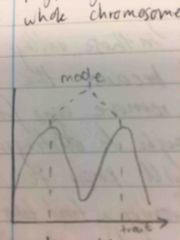
What selective pressure is this |
Disruptive |
|
|
What are homologous chromosomes |
Chromosome pairs, one from each parent, similar in length, gene position and centromere position |
|
|
What happens in meiosis I and meiosis II |
Meiosis I - introduces genetic diversity by randomly dividing a cell's genes in two resulting in 2 haploid cells Meiosis II - splits each chromosome into to chromatids and places one in each daughter cell resulting in 4 haploid gametes |
|
|
How does mutation cause genetic variation |
- deletion, addition or substitution of a nucleotide - deletion or translation of part of a chromosome - aneuploidy - polyploidy |
|
|
Define aneuploidy |
Loss or gain of a single chromosome |
|
|
Define polyploidy |
The addition of whole chromosome sets |
|
|
How does sexual recombination cause genetic variation |
- independent assortment of chromosomes in meiosis - crossing over during meiosis (chiasmata) - random fertilisation |
|
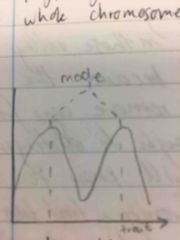
What selective pressure is this |
Disruptive |
|
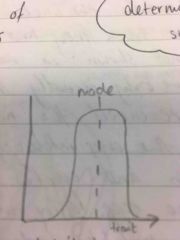
What selective pressure is this |
Stabilising |
|
|
What are homologous chromosomes |
Chromosome pairs, one from each parent, similar in length, gene position and centromere position |
|
|
What happens in meiosis I and meiosis II |
Meiosis I - introduces genetic diversity by randomly dividing a cell's genes in two resulting in 2 haploid cells Meiosis II - splits each chromosome into to chromatids and places one in each daughter cell resulting in 4 haploid gametes |
|
|
How does mutation cause genetic variation |
- deletion, addition or substitution of a nucleotide - deletion or translation of part of a chromosome - aneuploidy - polyploidy |
|
|
Define aneuploidy |
Loss or gain of a single chromosome |
|
|
Define polyploidy |
The addition of whole chromosome sets |
|
|
How does sexual recombination cause genetic variation |
- independent assortment of chromosomes in meiosis - crossing over during meiosis (chiasmata) - random fertilisation |
|
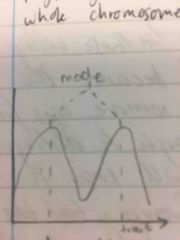
What selective pressure is this |
Disruptive |
|

What selective pressure is this |
Stabilising |
|
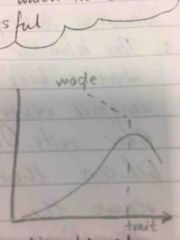
What selective pressure is this |
Directional |
|
|
What is the disadvantage of artificial selection |
It can lead to inbreeding which reduces genetic diversity. This can increase the risk of a disease affecting the whole population |
|
|
What are the advantages of artificial selection |
The desired genes and traits will be carried forward and undesired ones will be lost |
|
|
What are antibiotics |
Chemicals naturally produced by bacteria and fungi in order to kill other bacteria |
|
|
Why would bacteria and fungi produce antibiotics |
To eliminate the competing species and grant their own species more resources therefore higher chances of survival |
|
|
What did Alexander Fleming do |
Identify the properties of antibiotics |
|
|
What accelerates antibiotic resistance |
- The misuse and overuse of antibiotics - poor infection prevention and control - bacteria becoming antibiotic resistant so those with that trait survive and reproduce |
|
|
Define bacteriostatic |
Biological/ chemical agent stopping bacteria from reproducing |
|
|
Define bactericidal effect |
Where infections are suppressed by killing bacteria |
|
|
Define narrow spectrum |
An antibiotic which acts on a small range of disease-causing bacteria |
|
|
Define broad spectrum |
An antibiotic which acts on a wide range of disease-causing bacteria |
|
|
Give 3 ways in which antibiotics affect the target organisms |
- prevents the bacterium from building cell walls (leaky membranes) - stopping protein synthesis (bacteria cannot reproduce) - inhibit translation of proteins (protein synthesis) |

